At the 2024 Digital Expo, the Institute of Geochemistry of the Chinese Academy of Sciences and Alibaba Cloud jointly released the world's first "lunar science multi-modal professional large model". This is a major breakthrough in artificial intelligence technology in the field of lunar scientific research. This model is based on the Alibaba Cloud Tongyi series of models. It uses visual, multi-modal and natural language technologies, combined with RAG retrieval enhancement technology, to significantly improve the accuracy of identifying the age and shape of lunar impact craters, which has now reached more than 80%. This achievement will greatly accelerate the process of research on the lunar geological evolution and contribute to my country's lunar exploration undertakings.
At the 2024 Digital Expo, the Institute of Geochemistry of the Chinese Academy of Sciences and Alibaba Cloud jointly released the world's first "Multi-modal Professional Large Model of Lunar Science". This innovative model is based on the Alibaba Cloud Tongyi series of models and aims to improve the accuracy of identifying the age and shape of lunar impact craters. It has currently reached more than 80%.
This model combines visual, multi-modal and natural language general series models, and adopts RAG retrieval enhancement technology, fine-tuned and trained on Alibaba Cloud Bailian Exclusive Edition. The identification of lunar impact craters is its best landing scenario, which is of great significance for studying the geological evolution of the moon. The characteristics of impact craters, such as size, depth and shape, are key to understanding the moon's geological history.

Currently, the number of impact craters with a diameter of more than one kilometer on the moon has exceeded 1 million, while the number of impact craters with smaller diameters has not yet been determined. It is unrealistic to rely entirely on manual identification of these impact craters. The application of large professional lunar models has significantly improved the efficiency of scientific research. Researchers only need to input impact crater images and related questions, and the model can determine the modal type corresponding to the image from the multi-modal data and answer related questions.
In the future, large professional lunar models will be embedded in the "digital lunar cloud platform" to promote the intelligent upgrading of the platform. The platform, led by the Institute of Geochemistry of the Chinese Academy of Sciences, is the most comprehensive cloud platform for lunar exploration data in the world, integrating scientific research, engineering applications and popular science education. Together with large scientific installations such as FAST, it will become an important part of scientific research infrastructure and help accelerate my country's lunar and planetary scientific research innovation.
The successful release of this model marks the successful application of artificial intelligence technology in the field of lunar scientific research. In the future, it will further improve scientific research efficiency, promote the development of my country's lunar exploration industry, and make greater contributions to uncovering the mysteries of the moon. It will become an important part of the "Digital Lunar Cloud Platform" and provide strong technical support for global lunar research.